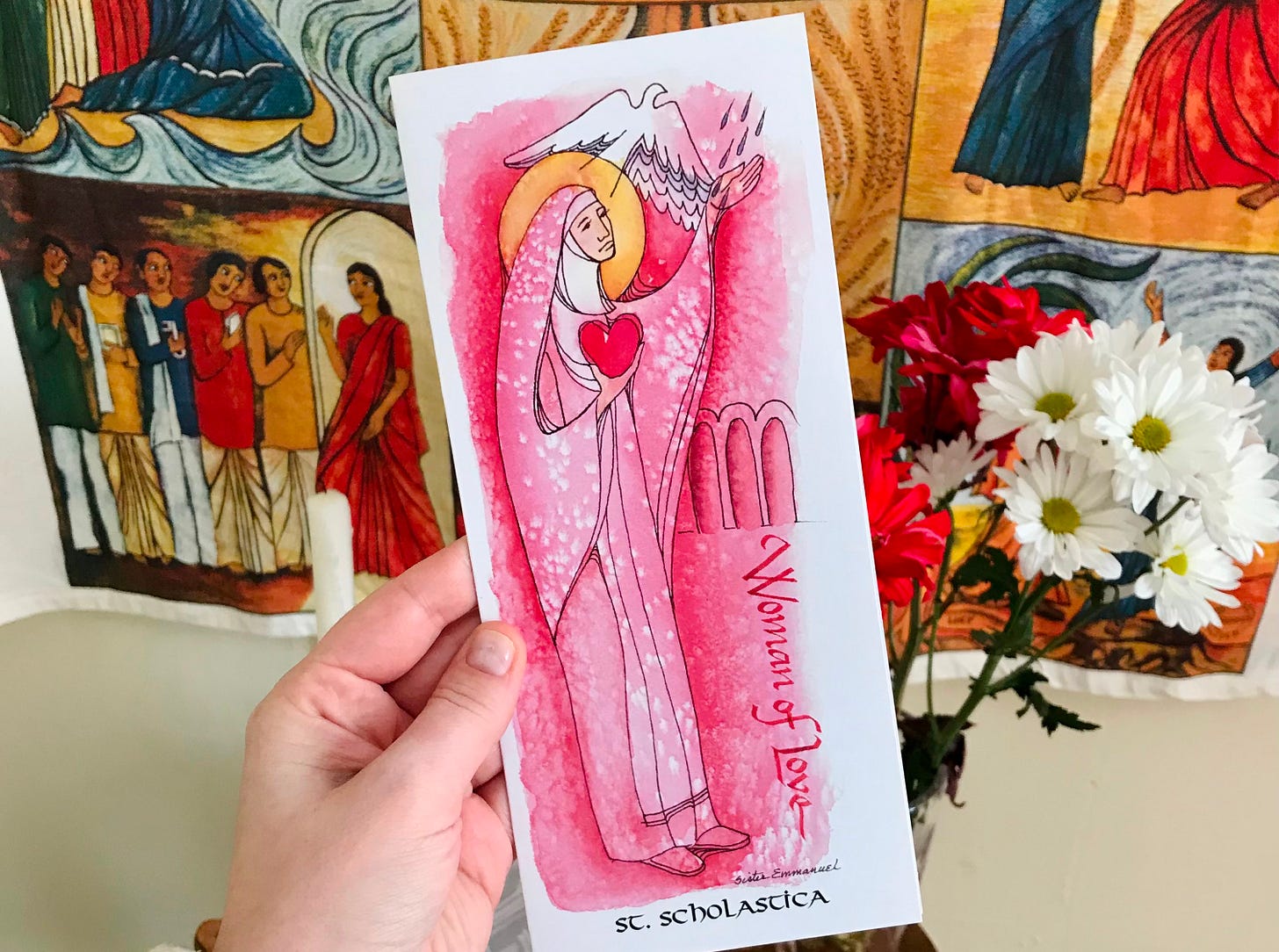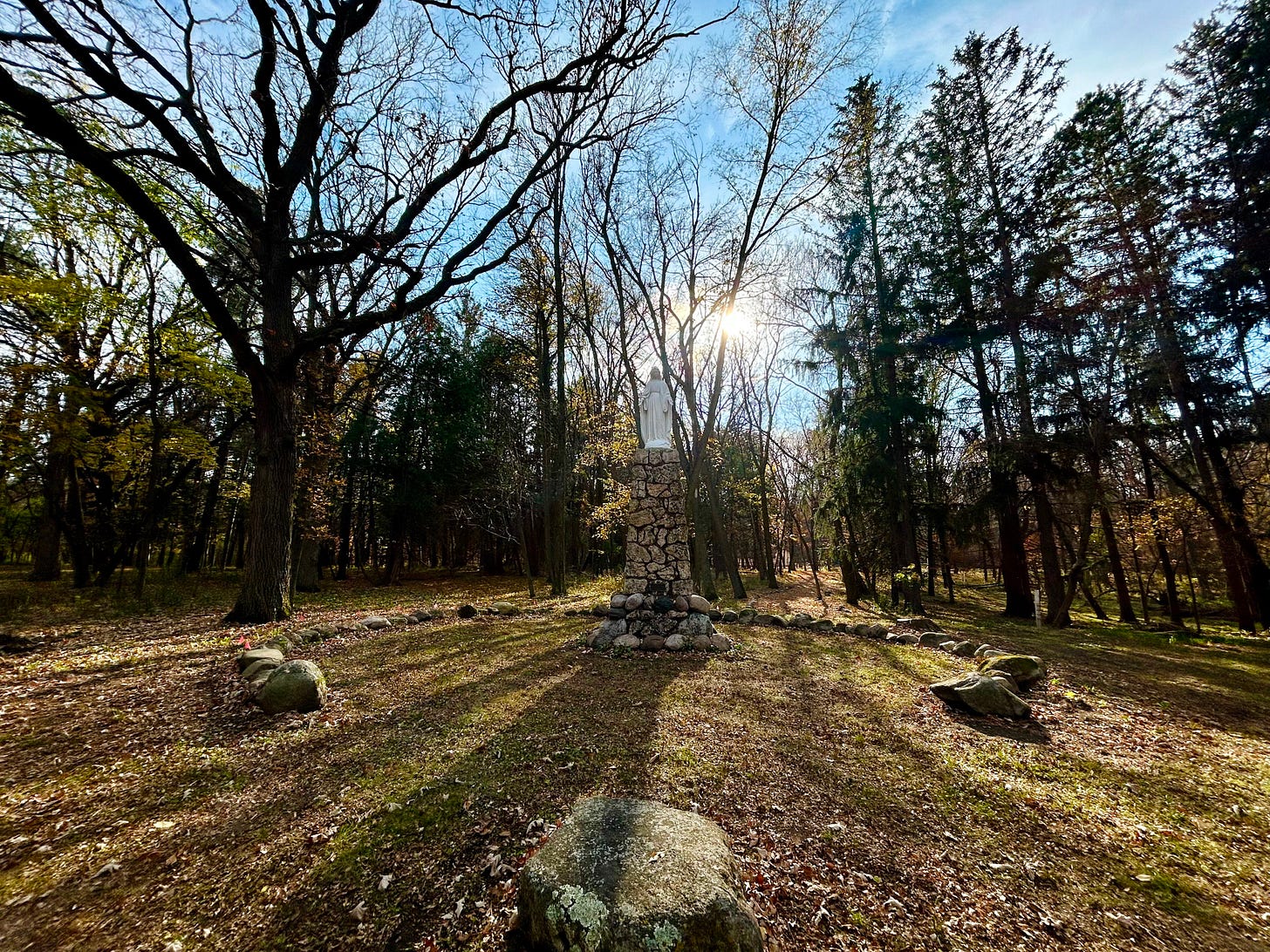This coming Monday is the Feast Day of Saint Scholastica, a foundress of women’s monasticism who led communities in sixth century Italy. The little we know about her is that she was a woman of deep prayer and power—someone who lived by her passion for spirituality lived in community.
Reflecting on her life, St. Gregory the Great had this to say about her—a short line that says a great deal:
She could do more because she loved more.
I’ve lingered with this line much over the last five years of monastic living. She could do more because she loved more. I return to it today, in the midst of political chaos, and it feels more important than ever—both to enact and sustain meaningful social action.
Inspired by Scholastica, two stories come to mind from recent weeks of building love and power in community. Even as I move through cycles of despair and discouragement each day, moments like these keep me returning to this invitation from Scholastica. I hope this helps you to identify those moments and places of hope that will sustain you in your contribution as well.
Shifting our attention from national to local
When the announcement was made a few weeks ago to pause federal funding for projects, so much was thrown up for question: Will our environmental efforts survive this? Will the daycare stay open? But that very night, there were three events in our city, and along with friends I went to all three. Rather than doom-scroll, I got out and into community.
First, the Erie Spiritual Coalition celebrated a local legislative success: the Tenant Bill of Rights was passed, thanks to over a year of the group’s advocacy, including months of petition-signing, and several City Council meetings attended and spoken at. That night, there was a room full of faith leaders and community organizers, celebrating this win that will have important implications for the well-being of people across our city. While celebrating the win, and planning what’s next, we were connecting—sharing concerns and tools for organizing, laughing and talking about our jobs and lives. One friend reminded me at the meeting: “Community will always move quicker than government.” Community will be what saves us.
Next, we drove over to the Eastside to attend the newly formed Erie Bike Co-op’s open house. People who bike for transportation and for fun, people who fix bikes and people who are new to them, all hung out in this garage surrounded by walls full of sticky notes with dreams. Walking around the space, we saw hundreds of bikes—some needing to be fixed up and some ready to be given away. Talking with others, I met organizers from the neighborhood network that originally started the effort years ago, and chatted with the fellow potential members of the cooperative. We shared our hopes for our city: better bike lanes, workshops on how to repair bikes, group rides to enjoy the beauty of our city, education events to empower us. One friend who helped plan the event described it as “a transportation revolution.”
We ended the night at the 10/20 Collective for an artists and creatives networking event. Catching up with the co-founder of the space, we heard about upcoming Seed Swap events, as well as a meditative concert and dance parties. We walked through the exhibits of local artists, one of which brought the wisdom of religious tradition into the otherwise secular space: on a little table, people knelt down to repent/reclaim—to “release what lies within…let go of a confession, a burden, or a truth.” There were votive candles, which people lit for those they lost. This “commUnity altar” brought together the grief and joy out of the hidden privacy of our lives and into a shared space and collective experience.
That night, amidst the national uncertainty of a funding freeze, local communities were still meeting up, building power, and finding joy. The spiritual coalition is volunteer-led; the bike co-op is a passion project of a few people; the artists who gathered don’t do what they do for money but for the love of art. Two days later, these would be the same relationships I turned to as we figured out how to respond to anti-immigration actions in our city. These spaces don’t negate the importance of responding to national crises, but they can help give us something real to return to each day, a place to practice the values we hold. These events put into sharp focus where we can find hope and joy, even as the ground shakes beneath us: in local community, gathered together by what we love.
Moving our hearts from apathy to empathy
This semester, I am teaching a class on Catholic Spirituality at a local university, and each day I wonder in the quiet classroom before we begin what it’s like to be a 19-year-old in our world. When I went to campus last week, I chatted with another professor before class about the latest news, and asked her if she could read the emotional state of her students. She said that she sees a range of apathy to overwhelm; some seem numb to the chaos, and others can’t sleep because of it. Then she shared: “Sometimes I think, if all we can do in our classes is build more empathy in them… to help them to actually care about the people next to them… then that’ll be enough.” I took this as a guide into my classroom: trying to move the students from apathy to empathy, from overwhelm to agency.
I was teaching on Saint Benedict that day, brother of Saint Scholastica and author of the Rule of Life that guides the community I live in. We had already explored the life of Jesus as well as the Desert Mothers and Fathers, and the refrain of these classes was consistent: spirituality is not just about beliefs, it’s how you embody them. And Christian spirituality means loving as Jesus loved, and seeing Christ in all people—especially those most oppressed and marginalized.
In the class on Benedict, we discussed Joan Chittister’s articulation of the monastic pillars in The Radical Christian Life: creative work, holy leisure, humility, stewardship, community, and peace. The students split into small groups on a pillar of their choice, read an excerpt, and discussed: What does this pillar have to do with spirituality? Do you witness or experience this pillar in your life, or not? What would it look like if this pillar were upheld by our society?
I was amazed by the responses. A usually timid classroom discussion felt energized. The pillars seemed to give some tangibility to the spiritual life that put ideas into practice. Some of the sentiments included:
You can’t just go to church and come home, and then ignore the needs of your neighbor. Your faith extends beyond prayer and into how you act in your daily life.
As a nation, we need a practice of humility and right relationship; we need to respect our neighbors, and provide care for people through our society’s economic systems.
Community is something we usually see arise in times of crisis, but we need it all the time. We need real relationships in order to survive and thrive.
The message from Richard Rohr’s “Universal Christ” seems to permeate our discussions, from the religious and non-religious students alike. If Christ is in all people, if Christ is in all creation, then this demands something of us. It calls us to mercy and compassion for all. No exceptions.
While we aren’t taking the latest political crisis head-on each day, the discussions none the less have political implications. Time and time again, these students mirror the teachings of the early Christians born two millennia before them: we are meant to love and care for people.

Scholastica’s life encourages me. She could do more because she loved more. I think of everyone who showed up at these community events, doing more and loving more, and I think of all of the students in my classroom, doing more and loving more. I think of who I hope to be in these times: doing more and loving more.
Our community spaces, our classrooms, and our spiritual lives all hold the potential to cultivate a love that incites us into action. Even in this time of chaos and instability, I am intentionally seeking out the things that will sustain me for the long-run: joy in community, love in action.
Scholastica is a good patron saint for this moment. From her, we inherit a lineage of love that expands our hearts to stretch and take on any crisis we come up against. From her, we learn to lean on community as the source of joy and strength that keeps us returning day after day to the challenges we face. This doesn’t take away any of the pain, fear, and heartbreak of our time, but it offers us a roadmap of how to live in the reality of it—grounded in and guided by love.
For her Feast Day and every day, a prayer: may we love more so we may do more.
Saintly & Subversive Women: A Lenten Series on Brigid of Kildare, Hildegard of Bingen, and Teresa of Avila
This Lent for Monasteries of the Heart, I am really looking forward to leading this eCourse on three radical Christian women. From their stories, I hope we will draw inspiration and courage for our own resistance and resilience today. The course is inspired in part by #CatholicWomenStrike, an effort from Women’s Ordination Conference to raise questions about women’s role in the Catholic Church today. This eCourse is our small offering of spiritual sustenance to those who are striking from the patriarchal church this Lent, and for anyone who seeks to stretch their hearts beyond what we can currently imagine.
The Radical Christian Life Book Club
Through monthly discussions on Zoom over the next ten months, seekers from across our global monastery will gather to consider what wisdom Benedict’s life has for us today. I am so looking forward to being in dialogue with Mary Ellen Plumb, Benedictine Sister, each month for an intergenerational and cross-vocational reflection on how we are invited to live the radical Christian life both within and beyond the monastery. Benedict provided a model for “living otherwise” that lasts with us today, and has gifts for all of us, especially those of us who are “spiritual but not religious.” If that is you, I hope you might join us!








Ohhh yes yes yes love this
This really raised me up. Thank you.